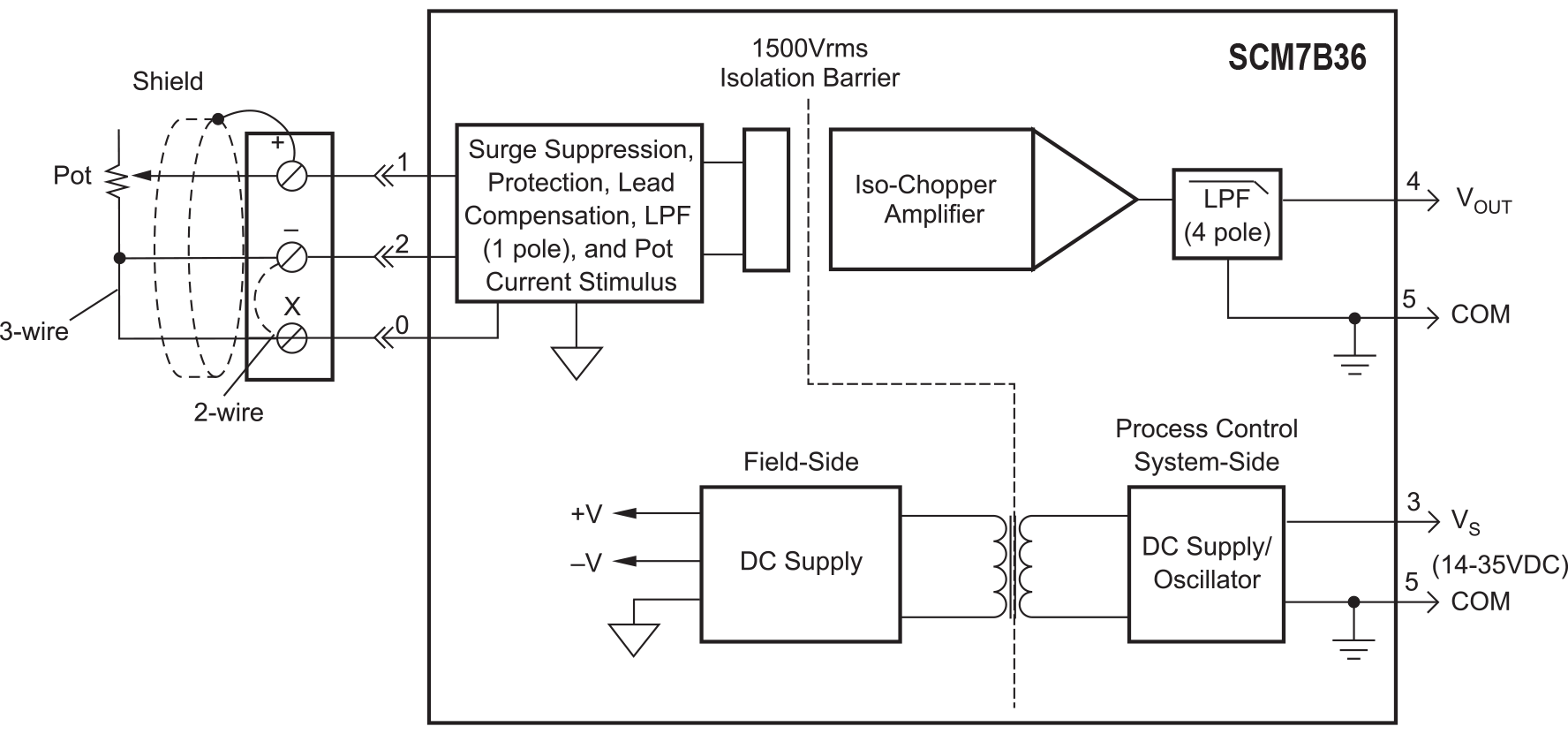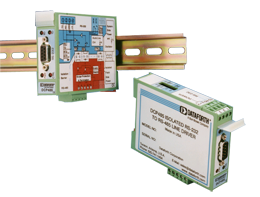SCM7B36
Isolated Potentiometer Input Modules
Each SCM7B36 Potentiometer input module provides a single channel of resistance input which is filtered, isolated, amplified, and converted to a high level analog voltage output.
The SCM7B36 module interfaces to slidewires and potentiometers in both two or three wire configuration and incorporates a five-pole filtering approach to maximize both time and frequency response by taking advantage of both Bessel and Butterworth characteristics. One pole of the filter is on the field side of the isolation barrier; four are on the process control system side. In the 3-Wire configuration, lead resistance compensation is provided if the resistance of the "x" lead is closely equivalent to that of the "+" lead. Internal to the module, measurement error due to lead resistance is canceled.
In response to the low level current excitation, and after initial field-side filtering, the input signal is chopped by a proprietary chopper circuit and transferred across the transformer isolation barrier, suppressing transmission of common mode spikes and surges. The signal is then reconstructed and filtered for process control system output.
Six standard input resistance ranges are offered, from 100 Ohm to 10k Ohm, with three output ranges available: 0-5V, 1-5V, and 0-10V. Modules accept a wide 14-35VDC power supply range (+24VDC nominal). Their compact packages (2.13" x 1.705" x 0.605" max.) save space and are ideal for high channel density applications. They are designed for easy DIN rail mounting using any of Dataforth's "-DIN" backpanels.
The SCM7B36 module interfaces to slidewires and potentiometers in both two or three wire configuration and incorporates a five-pole filtering approach to maximize both time and frequency response by taking advantage of both Bessel and Butterworth characteristics. One pole of the filter is on the field side of the isolation barrier; four are on the process control system side. In the 3-Wire configuration, lead resistance compensation is provided if the resistance of the "x" lead is closely equivalent to that of the "+" lead. Internal to the module, measurement error due to lead resistance is canceled.
In response to the low level current excitation, and after initial field-side filtering, the input signal is chopped by a proprietary chopper circuit and transferred across the transformer isolation barrier, suppressing transmission of common mode spikes and surges. The signal is then reconstructed and filtered for process control system output.
Six standard input resistance ranges are offered, from 100 Ohm to 10k Ohm, with three output ranges available: 0-5V, 1-5V, and 0-10V. Modules accept a wide 14-35VDC power supply range (+24VDC nominal). Their compact packages (2.13" x 1.705" x 0.605" max.) save space and are ideal for high channel density applications. They are designed for easy DIN rail mounting using any of Dataforth's "-DIN" backpanels.
Certifications
Documents
 3D CAD Models
3D CAD Models
Product Availability
Usually stock to 3-5 weeks. Contact Customer Service for current lead times.
Dimensions & Accessories
Features
- Industry's First 7B Potentiometer Input Module
- Interfaces 100 Ohm to 10k Ohm Potentiometers
- High Level Voltage Outputs
- 1500Vrms Transformer Isolation
- Accuracy, ±0.03% of Span Typical, ±0.1% Max
- ANSI/IEEE C37.90.1 Transient Protection
- Input Protected to 120VAC Continuous
- CSA Certified, FM Approved
- CE and ATEX Compliant
Block Diagram

Ordering
NOTE: Data in below table can be filtered. Please use the
to make your selection. If you have any questions about the displayed data,
please contact Customer Service at +1 520-741-1404 or sales@dataforth.com
FAQ
Can Dataforth analog modules be used in high vibration environments? If so, what type of testing or certification was completed?
SCM5B, SCM7B, 8B SensorLex, and DSCA modules are well suited for use in high vibration environments. These modules and their associated accessories have undergone testing for random vibration, shock, and swept sine wave vibration. Details of each of these testing methods are provided below:
Random Vibration (Operating):
○ MIL-STD 202G, Method 214A, Condition 1
- Frequency Range: 50-2000Hz, flat spectrum
- Vibration Intensity: 7.56 Grms
- Duration: 10min/axis (X, Y, Z)
Shock (Operating):
○ MIL-STD-810F, Method 516.5
- Pulse Shape: Sawtooth
- Test Level: 30G
- Duration 11ms
- Orientation: +/-X, +/-Y, +/-Z
Swept Sine Vibration (Operating)
○ MIL-STD-810G, Method 514.6, modified
- Frequency Range: 10-2000Hz
- Vibration Intensity: 5Gp-p
- Sweep Rate: 1 octave/min
- Orientation: X, Y, Z
Declaration of conformity for the above-listed tests can be provided upon customer request. Please contact customer service if a copy of the declaration is needed.
Due to resource constraints on my computer, I'm unable to open the three dimensional CAD models provided on your website. Does Dataforth provide two demensional CAD models for download as well?
Two dimensional CAD models can be generated upon customer request. Please contact Customer Service for assistance.
What does it mean when an input module has for example a 3kHz bandwidth?
A 3kHz bandwidth on an input module means it can accept voltages from DC to 3000Hz. Any frequency higher than that and the signal will start to be attenuated by the filter at the input.
Can SCM5B modules be hot swapped?
Not just SCM5B modules, but any signal conditioning module series and MAQ20 I/O modules can be hot swapped. A minimal amount of signal settling time may result, but there will be no damage to the device.
What does "Response time, 90% span" mean on the datasheet for my module?
Normally, a response time figure refers to how quickly a module's output can "respond" to a change in the input signal. "Response time, 90% span" refers to how fast a module can adjust its output when a step signal is applied at the input, where the magnitude of this step input is 90% of the input span of the module.
Where can I find the MTBF of my module?
Information on MTBF for SCM5B, SCM7B, 8B and DSCA is available on our website. Please see application note AN802 for more details. Application notes can be found under the "Literature" tab on the top navigation bar.
Is the calibration of Dataforth modules traceable to NIST standards?
Yes, calibration of Dataforth modules is traceable to NIST standards.
If I purchase a backplane with no CJC, will I still be able to use modules that require the CJC enable jumper to be installed?
Yes. Backplanes with no CJC will still come with the CJC enable installed on the backplane.
How does the load resistance of a module affect the noise at the output?
Noise at the output of a module is independent of load resistance.
How do I convert an RMS voltage to its corresponding peak voltage?
To convert an RMS voltage to its corresponding peak voltage, you simply take the RMS voltage value and multiply it by the square root of 2, or roughly 1.414.
For example, 1500Vrms corresponds to a peak voltage of 1500 * 1.414 = 2121 Vp
If the input range of my signal conditioner is -1V to +1V and the output range is 0 to 10V, does this mean that it ignores polarity?
A signal conditioner with these I/O ranges does not mean that the module ignores the polarity of your voltage input. The output of voltage input modules are scaled linearly, meaning an input of -1V would correspond to an output of 0V, an input of 0V would correspond to an output of 5V, an input of +1V would correspond to an output of 10V, and so on.
Is the SCMXPRT-003 DIN rail mountable?
The SCMXPRT-001 has an option for DIN rail mounting (part number: SCMXPRT-001D) but the SCMXPRT-003 does not. Instead, it can be mounted on the SCMXRK-002 which is a 19 inch metal rack for mounting the SCMXPRT-003 as well as various Dataforth backpanels and the SCMXIF interface board.
Analog Devices announced a last time buy and discontinuance of their signal conditioning modules. Can I replace them with Dataforth signal conditioning modules?
Yes, in general, Dataforth signal conditioning modules are a direct replacement for all Analog Devices signal conditioning modules. e.g. "SCM5B35-xx: Linearized 4-Wire RTD Input Modules" will replace Analog Devices "5B35: Isolated 4 Wire RTD Input Signal Conditioning Module".
Please note that Dataforth signal conditioning modules are RoHS II compliant.
Can Dataforth provide calibration reports for modules I purchased?
Yes we can provide calibration reports for the modules that you purchased.
You can either
a) visit https://www.dataforth.com/TestDataReport.aspx to search for Test Report Datasheets by Serial Number or
b) you can send us a list of model numbers and their serial numbers to support@dataforth.com
Custom Modules
Below is a list of existing custom modules. If you don't see a module matching your target specifications, contact Customer Service and Application Support to discuss design guidelines and
design feasibility. Customer Service and Application Support can be reached at
sales@dataforth.com or +1-800-444-7644.
NOTE: Data in below table can be filtered. Please use the
to make your selection. If you have any questions about the displayed data,
please contact Customer Service at +1 520-741-1404 or sales@dataforth.com
* ... Status Codes: PR = Production, PT = Prototypes, QU = Quoted
We want your feedback!
We are interested in your feedback regarding our products. Please let us know what you think and if you have any questions regarding the SCM5B32 and how this product could apply to your application. Your feedback is very valuable to us and very much appreciated.
Was this content helpful?
Thank you for your feedback!







